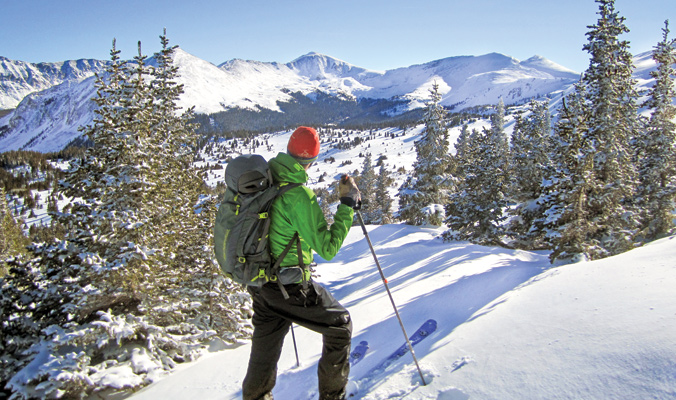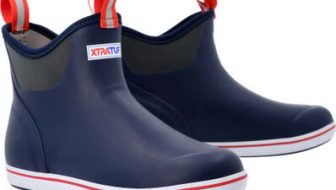As an avalanche course instructor, I’m often confronted with students who come to me with a ton of questions after taking an Avy Level 1 course. In a lot of ways, that’s what Level 1 courses are for: inspiring questions and pointing out just how complex avalanches really are and how difficult terrain management can be.
But the anxiety about the dangers of avalanche terrain can be debilitating. I reassure people that these feelings of ineptitude will slowly evolve into a healthy respect for the mountains and that no matter how long you have been making turns, you will always have questions about proper safety techniques. There are unfortunately no magic snowpack tests or short cuts to making decisions that eliminate this anxiety, but the good news is that gaining experience is half the fun.
Here are a few tools to help overcome that avalanche-education anxiety in order to take the lessons of an avy course into the field.

Gram in his element. [Photo] Courtesy Buena Vista Mountain Adventures
Experience is the best teacher
No one ever gained experience doing things right the first time; mistakes are how we learn and catalogue what works and what doesn’t. Looking back, I’ve made a ton of mistakes—we’re all human; it happens. The key to learning from errors, however, is recognizing what went wrong and knowing how to apply the correct solution in the future.
Debriefing is the key to a heightened level of self-awareness. Instead of ending your tour with “that was a great day, see you next week,” talk to your partners about what went right and what could have been improved upon. With these après discussions, you start to unearth comments from group members like, “We were super efficient on the uphill today, but I didn’t really like how we passed under that steep, wind-loaded slope above that gully.”
This is a perfect segue into discussing how you can mitigate or avoid that situation altogether in the future. Be critical of yourself and your ski partners without being a jerk about it.
Start off slow
The mountains aren’t going anywhere, so take baby steps as you become comfortable moving in the backcountry. Start off in relatively simple terrain, and only when you feel comfortable dealing with variables in those conditions should you move to more complex zones as conditions allow.
Remember, terrain choice is the ultimate method for managing risk, so don’t set yourself up for failure by spending too much time in terrain with high consequences while conditions present a likelihood for instability; this usually doesn’t end with good results.
Soak it up
Strive to be an information-gathering sponge. There is a lot of avalanche information out there, so it’s up to you to make the most of it. Read your avalanche bulletin every day, even if you aren’t skiing. This keeps you updated on the weather and snowpack information you might miss while your skis sit in the garage. Read books, blogs and magazine articles to stay informed about the latest avy-safety techniques and other important gear and terrain-management findings that might have changed since you took your last avalanche course.
When you’re out in the field, write down your observations and make sure to share and compare them with others. This way, your observations won’t remain unread and unchallenged. Think of it like a school assignment: you don’t get better by writing a paper and not turning it in, so why would you write observations and not share them with others to verify your findings?
Find a mentor
I would have given up as a backcountry skier without some of the exceptional people who offered me guidance along the way. Find someone you trust to take you under his or her wing. If this is difficult, go out with a guide and ask as many questions as possible, like, “Where are we going?” and “Why are we going there?” Don’t be afraid to ask for constructive feedback on your terrain-management choices, pit-digging technique and communication skills. This may sting a bit, but it’s worth it.
There is a time and place to say yes
When I first started skiing the backcountry, I was very hesitant to say “yes” to skiing anything with consequences. Because of this I’m sure I missed out on some valuable experiences. If you’ve done your research on the day’s conditions, have read previous observations from the area in which you plan to travel and feel that your group collectively have the experience and problem-solving tools to work through potential challenges, then it might be time to work toward a slightly bigger objective.
—
Originally from Wisconsin, Tommy Gram now works as a ski guide and AIARE Avalanche Instructor for Buena Vista Mountain Adventures (BVMA) in Colorado. He is passionate about teaching others how to have fun and stay safe in wilderness environments and is dedicated to a career in the outdoor industry.









Thanks for this sound advice. I definitely felt a bit paralyzed after my Avy I course.
I tried to post a comment twice and it doesn’t show up. Not sure if my thoughts just aren’t appproved or if I’m doing something wrong. If anyone at Backcountry sees this, lmk!
(Okay third time trying to post a comment)
I think the author is dead-on about how Avy 1 makes students feel. Not empowered or excited, that’s for sure.
I see a lot of people getting into touring who aren’t interested in debriefing, digging pits, etc and while they may do some education, the AIARE framework doesn’t really provide a way forward for those people. Personally I think the industry, if you can call it that, needs to find a way to serve the recreational person who just wants a recreational outlet that doesn’t require becoming a snow scientist. Wonder what the author thinks.
Hey Justin, Thanks for the comment. There are big changes coming this season the the AIARE Framework and curriculum as the Recreational and Professional courses are now split with a L1, Rescue and L2 courses under the recreational umbrella. I think this change will definitely help recreational Backcountry skiers. Hope this helps!
Why would anyone listen to someone from Wisconsin? These are the ‘experts’ that always are the ones getting hurt.
I know fully certified IFMGA guides from Missouri and Maine, that could smoke anyone on the planet in the mountains…As an aspiring guide the author is spot on with the anxiety of pushing into big and uncertain terrain and yes, in CO, in the San Juans it’s no joke.
Thanks for writing Tommy!
I’d love to see what credentials you have J, regardless of where you’re from.